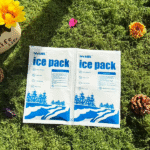Dry Ice Pack for Back Pain: Should You Try It?
Considering a dry ice pack for back pain because regular ice just isn’t cutting it? Hold up—solid CO₂ hits –78 °C, well below skin‑safe ranges and one slip can mean frostbite. This guide breaks down the science, safer cold‑therapy choices, and 2025 gear that calms spasms without the burn.
-
Why is dry ice too extreme for muscle pain relief?
-
What temperature actually speeds recovery and blocks inflammation?
-
Which modern gel packs and cryo wraps outperform old‑school ice?
-
How can you apply cold therapy correctly in the first 72 hours post‑injury?
-
What myths about back‑pain icing should you ignore in 2025?
Why Is Dry Ice a Bad Idea for Back Pain?
Dry ice sits at –78 °C; muscle and skin cells start freezing below –10 °C, risking tissue necrosis, nerve damage, and pigmentation loss in seconds. Medical guidelines for acute soft‑tissue injuries recommend 10 °C–15 °C exposure for 10‑20 minutes, not sub‑zero extremes. Frostbite can worsen soreness and delay healing—exactly the opposite of what you want.
“We never use dry ice on patients—temperatures that low destroy tissue,” says Dr. Lane Kim, sports‑medicine lead at a 2024 Olympic training camp.
Temperature vs. Tissue Safety
| Contact Temperature | Safe Exposure Window | Likely Outcome |
|---|---|---|
| 15 °C–10 °C | 10–20 min | Reduces swelling & pain |
| 0 °C | 5–10 min | Numbness, surface discomfort |
| –20 °C | < 60 s | Capillary damage, blister risk |
| –78 °C (Dry Ice) | < 5 s | Frostbite, deep tissue loss |
Safer Cold‑Therapy Alternatives for Back Pain
-
Phase‑Change Gel Packs (10 °C set‑point)
Pre‑freeze 2 hours; straps hold pack in lumbar curve for 15 minutes. -
Compression Cryo Wraps (‑5 °C to 5 °C range)
CO₂ or water‑circulation sleeves deliver uniform chill and light pressure. -
Instant Chemical Cold Packs
Good for field emergencies; tap to activate then apply through a cloth.
Case study: A marathon runner swapped dry‑ice experiments for a –5 °C compression wrap and cut recovery time from strain by two days.
How to Apply Cold Correctly in the First 72 Hours
-
20‑Minute Rule: Chill 15–20 min, remove 40 min, repeat 3–4× daily.
-
Barrier First: Thin cloth prevents ice burn even with gel packs.
-
Combine R.I.C.E.: Rest, Ice, Compression, Elevation (flat back, knees bent).
-
Switch to Heat: After swelling subsides (~72 h), use 40 °C heat pads to boost circulation.
Pro Tips for Daily Pain Managers
-
Working from home? Keep a pair of PCM lumbar wraps at 10 °C in your mini‑fridge—ready after long desk sessions.
-
On the road: Pack two instant cold packs plus a stretch band—a 30‑second break can stop spasms before they escalate.
-
Sensitive skin: Opt for menthol gels that mimic cooling without dropping tissue temperature.
Busting 2025 Internet Myths about Dry Ice & Back Pain
| Myth | Reality Check |
|---|---|
| “Colder is always better for pain.” | Below –10 °C, nerves freeze—pain rebounds worse. |
| “A towel makes dry ice safe.” | –78 °C penetrates fabric fast; still dangerous. |
| “Dry ice speeds muscle recovery.” | No studies support this; risk outweighs any benefit. |
2025 Innovations in Cold‑Chain Pain Relief
-
Plant‑Based PCM Belts: Hold 12 °C for 90 minutes, fully curbside‑recyclable.
-
NFC‑Logged Cryo Wraps: Track skin contact temp; app alerts if colder than 8 °C.
-
Hybrid Heat‑Cold Units: Switch from 12 °C cooling to 42 °C heating with one flip—ideal for injury‑to‑recovery cycles.
Market forecasts show a 13 % CAGR for smart cryo‑therapy devices through 2028 as athletes ditch risky hacks for data‑driven solutions.
FAQ
Is any dry ice contact time safe on the back?
No. Even brief contact risks deep‑tissue frostbite; stick to controlled 10–15 °C packs.
Can I place dry ice near—not on—my back to cool the air?
CO₂ gas displaces oxygen; inhalation in enclosed spaces can cause dizziness. Avoid indoor use.
How soon after a strain should I start icing?
Within the first hour for best anti‑inflammatory effect; continue the 20‑minute cycle for 48–72 hours.
Summary & Recommendations
Using a dry ice pack for back pain is unsafe and counter‑productive. For real relief, keep cold therapy between 10 °C and 15 °C, follow 20‑minute cycles, and consider smart cryo wraps that monitor skin temperature.
Action plan:
-
Ditch any sub‑zero blocks or dry‑ice ideas.
-
Buy a PCM lumbar wrap—aim for 10 °C hold.
-
Set reminders to ice 3–4× daily for two days, then transition to gentle heat.
About Tempk
We build recyclable thermal gear that protects cargo—and people. Our Bio‑Relief™ lumbar wrap uses plant‑based PCM, stays at 12 °C for 90 minutes, and is lab‑tested for safe skin contact.
Need personalized recovery tips? Book a free consult.
























